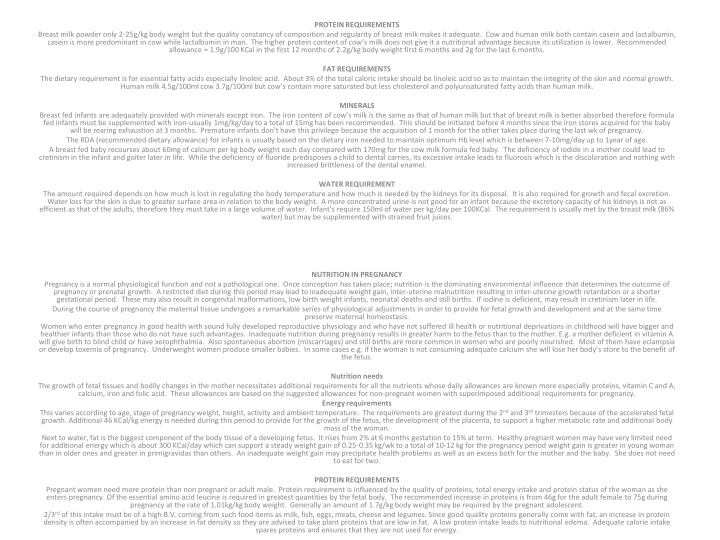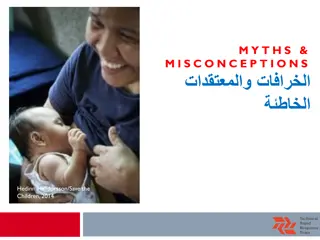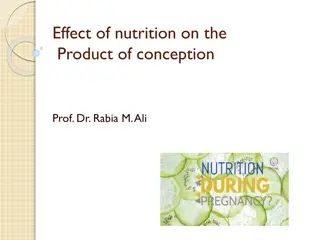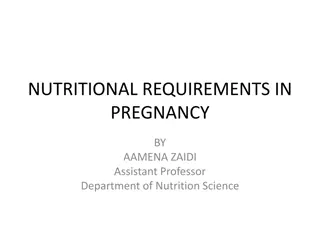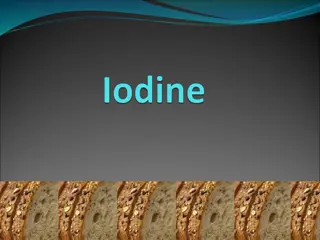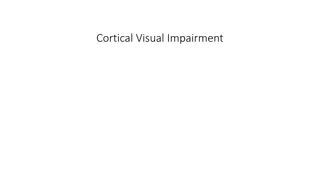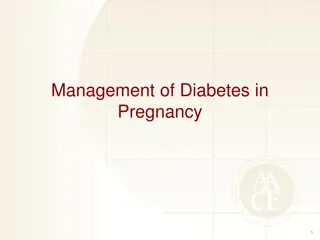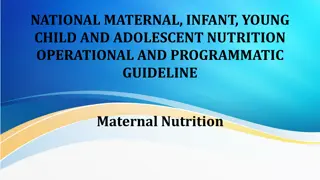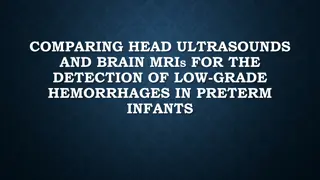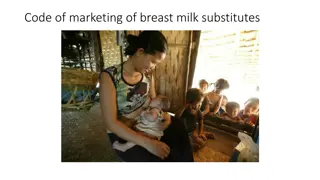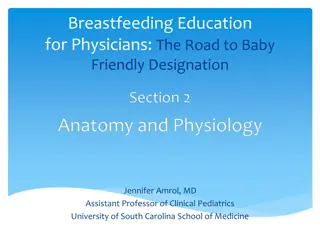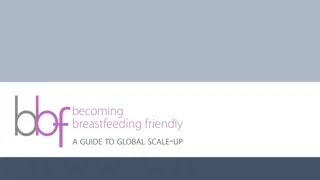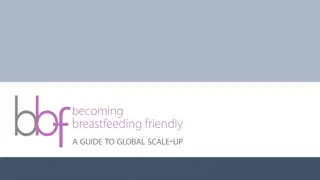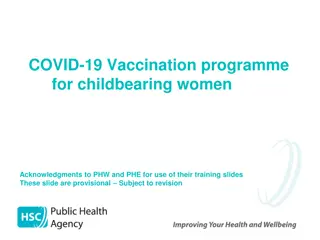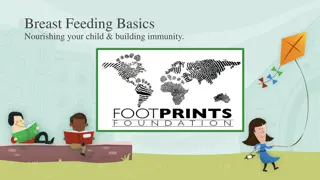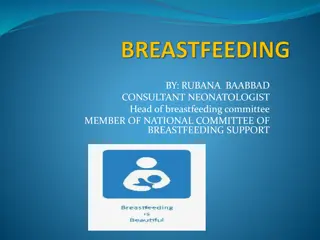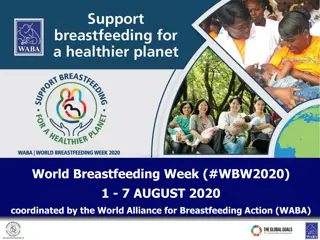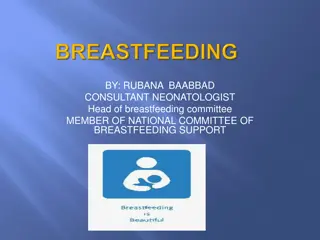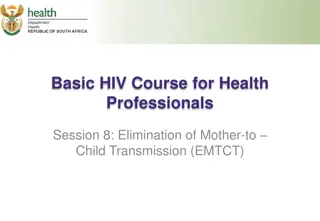Nutritional Requirements for Infants, Breastfeeding, and Pregnancy
Breast milk powder provides adequate protein for infants, while cow and human milk have varying qualities. Essential fatty acids are crucial for skin integrity and growth, and infants may need iron supplementation if formula-fed. Pregnancy nutrition is vital for fetal development, with deficiencies leading to complications and malformations. Adequate calcium, iron, and folic acid intake is crucial during pregnancy.
Download Presentation

Please find below an Image/Link to download the presentation.
The content on the website is provided AS IS for your information and personal use only. It may not be sold, licensed, or shared on other websites without obtaining consent from the author.If you encounter any issues during the download, it is possible that the publisher has removed the file from their server.
You are allowed to download the files provided on this website for personal or commercial use, subject to the condition that they are used lawfully. All files are the property of their respective owners.
The content on the website is provided AS IS for your information and personal use only. It may not be sold, licensed, or shared on other websites without obtaining consent from the author.
E N D
Presentation Transcript
PROTEIN REQUIREMENTS Breast milk powder only 2-25g/kg body weight but the quality constancy of composition and regularity of breast milk makes it adequate. Cow and human milk both contain casein and lactalbumin, casein is more predominant in cow while lactalbumin in man. The higher protein content of cow s milk does not give it a nutritional advantage because its utilization is lower. Recommended allowance = 1.9g/100KCalin the first 12 months of 2.2g/kg body weight first 6 months and 2g for the last 6 months. FAT REQUIREMENTS The dietary requirement is for essential fatty acids especially linoleic acid. About 3% of the total caloric intake should be linoleic acid so as to maintain the integrity of the skin and normal growth. Human milk 4.5g/100ml cow 3.7g/100ml but cow s contain more saturated but less cholesterol and polyunsaturated fatty acids than human milk. MINERALS Breast fed infants are adequately provided with minerals except iron. The iron content of cow s milk is the same as that of human milk but that of breast milk is better absorbed therefore formula fed infants must be supplemented with iron-usually 1mg/kg/day to a total of 15mg has been recommended. This should be initiated before 4 months since the iron stores acquired for the baby will be rearing exhaustion at 3 months. Premature infants don t have this privilege because the acquisition of 1 month for the other takes place during the last wk of pregnancy. The RDA (recommended dietary allowance) for infants is usually based on the dietary iron needed to maintain optimum Hb level which is between 7-10mg/day up to 1year of age. A breast fed baby recourses about 60mg of calcium per kg body weight each day compared with 170mg for the cow milk formula fed baby. The deficiency of iodide in a mother could lead to cretinism in the infant and goiter later in life. While the deficiency of fluoride predisposes a child to dental carries, its excessive intake leads to fluorosis which is the discoloration and nothing with increased brittleness of the dental enamel. WATER REQUIREMENT The amount required depends on how much is lost in regulating the body temperature and how much is needed by the kidneys for its disposal. It is also required for growth and fecal excretion. Water loss for the skin is due to greater surface area in relation to the body weight. A more concentrated urine is not good for an infant because the excretory capacity of his kidneys is not as efficient as that of the adults, therefore they must take in a large volume of water. Infant s require 150ml of water per kg/day per 100KCal. The requirement is usually met by the breast milk (86% water) but may be supplemented with strained fruit juices. NUTRITION IN PREGNANCY Pregnancy is a normal physiological function and not a pathological one. Once conception has taken place; nutrition is the dominating environmental influence that determines the outcome of pregnancy or prenatal growth. A restricted diet during this period may lead to inadequate weight gain, inter-uterine malnutrition resulting in inter-uterine growth retardation or a shorter gestational period. These may also result in congenital malformations, low birth weight infants, neonatal deaths and still births. If iodine is deficient, may result in cretinism later in life. During the course of pregnancy the maternal tissue undergoes a remarkable series of physiological adjustments in order to provide for fetal growth and development and at the same time preserve maternal homeostasis. Women who enter pregnancy in good health with sound fully developed reproductive physiology and who have not suffered ill health or nutritional deprivations in childhood will have bigger and healthier infants than those who do not have such advantages. Inadequate nutrition during pregnancy results in greater harm to the fetus than to the mother. E.g. a mother deficient in vitamin A will give birth to blind child or have xerophthalmia. Also spontaneous abortion (miscarriages) and still births are more common in women who are poorly nourished. Most of them have eclampsia or develop toxemia of pregnancy. Underweight women produce smaller babies. In some cases e.g. if the woman is not consuming adequate calcium she will lose her body s store to the benefit of the fetus. Nutrition needs The growth of fetal tissues and bodily changes in the mother necessitates additional requirements for all the nutrients whose daily allowances are known more especially proteins, vitamin C and A, calcium, iron and folic acid. These allowances are based on the suggested allowances for non-pregnant women with superimposed additional requirements for pregnancy. Energy requirements This varies according to age, stage of pregnancy weight, height, activity and ambient temperature. The requirements are greatest during the 2ndand 3rdtrimesters because of the accelerated fetal growth. Additional 46 KCal/kg energy is needed during this period to provide for the growth of the fetus, the development of the placenta, to support a higher metabolic rate and additional body mass of the woman. Next to water, fat is the biggest component of the body tissue of a developing fetus. It rises from 2% at 6 months gestation to 15% at term. Healthy pregnant women may have very limited need for additional energy which is about 300 KCal/day which can support a steady weight gain of 0.25-0.35 kg/wk to a total of 10-12 kg for the pregnancy period weight gain is greater in young woman than in older ones and greater in primigravidas than others. An inadequate weight gain may precipitate health problems as well as an excess both for the mother and the baby. She does not need to eat for two. PROTEIN REQUIREMENTS Pregnant women need more protein than non pregnant or adult male. Protein requirement is influenced by the quality of proteins, total energy intake and protein status of the woman as she enters pregnancy. Of the essential amino acid leucine is required in greatest quantities by the fetal body. The recommended increase in proteins is from 46g for the adult female to 75g during pregnancy at the rate of 1.01kg/kg body weight. Generally an amount of 1.7g/kg body weight may be required by the pregnant adolescent. 2/3rdof this intake must be of a high B.V. coming from such food items as milk, fish, eggs, meats, cheese and legumes. Since good quality proteins generally come with fat, an increase in protein density is often accompanied by an increase in fat density so they are advised to take plant proteins that are low in fat. A low protein intake leads to nutritional edema. Adequate calorie intake spares proteins and ensures that they are not used for energy.
ENERGY REQUIREMENT Reduction in energy requirement occurs because (1) Activity declares in the aged, so less energy is expanded. (2) Changes in body composition and function lead to a reduction in basal metabolic rate. e.g. for men 15-35years 3000 KCal (moderate activity) 35-65years 65-75years 75 years For women it drops from 2200KCal at age 18 to 1810KCal at the age of 75years. This reduction means that the diet has to be of a high nutritional quality to ensure that the requirements for all other nutrients are met while the energy intake is reduced. Requirement is about 400 KCal/day, 30-50% can be provided as fat. Condition where more fat is used includes diabetes mellitus and stress induced glucose tolerance. Providing too many calories is very dangerous because it can lead to electrolyte imbalances, hypokalcemia, cardiac dysfunction and even death. 2900KCal (moderate activity) 2350 KCal (sedentary life) 2100 KCal (sedentary life) Protein: There is a slight increase in protein requirement with age. 1g protein /kg/day. In stress it is increased to 2g protein intake is restricted in renal and hepatic insufficiency. Fluid and Electrolyte Diminished fluid intake and an altered response to thirst are common in the elderly. Some may voluntarily decrease their fluid intake due to problems with incontinence or decrease going to toilet. Medications may increase urine output. Vitamin and trace elements Decreased gastric acid secretion which is common in the elderly results in the absorption of several vitamins e.g. B12and folate and trace elements Fe, Zn. Medication can also affect absorption of micronutrients e.g. fibre supplements. Additional Ca is needed for the prevention and treatment of osteoporosis. Some micronutrients have beneficial effect on immune functions (Vitamin. A, C, D, E, B6, folate, Zn) for wound healing (Vitamin A, C, B2, Zn, Se) and antioxidant functions (Vitamin C, E and Se). Malnutrition in older people can be divided into: 1. Generalized malnutrition: The diet count inadequate supplies of several nutrients which can be due to self neglect, illness, disability depression and bereavement. 2. Deficiency of a particular nutrient: Occurs when a particular food or group of foods is excluded from the diet e.g. (a) Iron deficiency in those with poor teeth who avoid meat because of chewing, or due to its cost. (b) Low vitamin intake in those who have little fruits and vegetable in the diet may be due to difficulty in shopping etc. (c) Folic acid: also from vegetable and yeast extracts. 3. Subclinical malnutrition: The diet is not so poor that they show clinical features of malnutrition but the body stores of nutrients are depleted. If exposed to any stress they become clinically malnourished. Causes of malnutrition in older people Malnutrition is normally precipitated by other social, physical or medical problem. 1. Age: The increasing frailty of extreme old age increases the risk of malnutrition. 2. Social isolation and loneliness: Most elderly people live alone. They cannot be bothered to cook for themselves; they cannot buy meat because they buy only small quantity. Widower s disease applied to vitamin C deficiency is very common. 3. Loss of appetite: Enjoyment of food depends on usual appearance, taste and smell of it. Reduction of the activity of these sense organs leads to decrease in appetite. The perception of salt and sweetness also decrease greatly while bitterness remains unchanged. Salivary secretion also in older people contributes to loss of taste and makes chewing and swallowing more difficult. Remedy: they need encouragement to take interest in food and their appetite needs to be stimulated to help overcome the reduction in taste and smell. 4. Teeth: The daily energy intake of older people with ill fitting dentition is 200 to 300 KCal less than for those with adequate dentition because eating is uncomfortable and they adopt a soft bland diet. 5. Dysphagia: Is a condition in which swallowing is either difficult or painful may be due to multiple sclerosis, cerebrovascular attack, surgery, confusion, radiotherapy etc. Remedy: physiotherapy, dietitician, intravenous fluids, supplementary feeding etc. Physical disability 10% of elderly people are housebond because of physical disabilities due to hemiplegia, arthritis, Parkinson s disease, injuries from accidents etc. Remedy: convenience foods can help a lot in this case. Mental disturbances Servicedementia affects 5% of the post retirement population. So they forget to prepare or eat meals. Some are depressed they may forget to go to the market to buy food stuffs. Remedy: treatment for depression. Therapeutic diets
NUTRITION IN THE ELDERLY The maximum age for man is 110 years even though very few attain this age. After retirement, very few people look forward to old age because they see it as a time when with failing faculties they will no longer be able to live useful independent lives. The degenerative changes which accompany aging include: - Loss of sensations of smell and taste - Deafness, failing sight, osteoarthritis, osteoporosis, arterial diseases, reduction of glucose tolerance and declare in muscle bulk and strength. At this time, cardiac, renal and pulmonary functions decrease with aging, also changes in GIT functions occur poor dentition and gastric emptying gastric acid production. Good nutrition however improves the quality of life of older people and as medical treatment improves the population lives longer. The nutritional requirements for most nutrients for older people are the same as those of the younger population. The only exception are a fall in energy requirement with age and an increased requirement for vitamin D in the house bound since they are less active and use less energy. It can be difficult for older people to have a diet that is nutritionally adequate when their appetite is poor, or when in pain or have a disability. 1. 2. Remedy: see dietitian Dealing with problems affecting nutrition in the elderly 1. Loss of teeth: cut food into small pieces, crush. Add gravy or other liquid to food make chewing easy, e.g. thick soup, porridge, milk drinks, fruit juice and mashed potato. Loss of appetite Prepare colorful and tasty meals based on balanced diet Serve nourishing meals in pleasant surroundings and eat slowly Poor digestion and constipation Serve fresh fruits and vegetables, cooked vegetables and stewed fruits. Lack of money Buy low cost locally produced foods, keep a home garden. Loneliness Family and friends should spend time with them especially at meal times. Give them roles in the family maybe taking care of the young ones. If the older person is sick get a doctor and a dietitian or nutritionist to help. Nutritional assessment of the elderly 1. Height and weight measurement and calculation of the body mass index. If it is impossible to obtain an accurate weight measurement especially for a disabled or confused patient, then measuring the demispan may be easier (web of the outstretched finger to the sternal notch and is related to height. History: Discuss clients current weight steady loss or gained Discuss appetite, meals, any diarrhea, sore month etc. Physical appearance look fat/thin, clothes loose or not loose dentures. Serum albumin, transferin and haemoglobin are all important biochemical parameters for assessing nutritional status. Health education programs aimed at older people including those who work with them should be encouraged. Pre-retirement course not only in business but also include session in which nutrition is discussed. Keeping to a strict weight reduction diet long after the ideal target weight has been reached. Self improved exclusion of carbohydrate in a well intentioned attempt to control diabetes.
NUTRITION IN THE ELDERLY The maximum age for man is 110 years even though very few attain this age. After retirement, very few people look forward to old age because they see it as a time when with failing faculties they will no longer be able to live useful independent lives. The degenerative changes which accompany aging include: - Loss of sensations of smell and taste - Deafness, failing sight, osteoarthritis, osteoporosis, arterial diseases, reduction of glucose tolerance and declare in muscle bulk and strength. At this time, cardiac, renal and pulmonary functions decrease with aging, also changes in GIT functions occur poor dentition and gastric emptying gastric acid production. Good nutrition however improves the quality of life of older people and as medical treatment improves the population lives longer. The nutritional requirements for most nutrients for older people are the same as those of the younger population. The only exception are a fall in energy requirement with age and an increased requirement for vitamin D in the house bound since they are less active and use less energy. It can be difficult for older people to have a diet that is nutritionally adequate when their appetite is poor, or when in pain or have a disability. 1. 2. Remedy: see dietitian Dealing with problems affecting nutrition in the elderly 1. Loss of teeth: cut food into small pieces, crush. Add gravy or other liquid to food make chewing easy, e.g. thick soup, porridge, milk drinks, fruit juice and mashed potato. Loss of appetite Prepare colorful and tasty meals based on balanced diet Serve nourishing meals in pleasant surroundings and eat slowly Poor digestion and constipation Serve fresh fruits and vegetables, cooked vegetables and stewed fruits. Lack of money Buy low cost locally produced foods, keep a home garden. Loneliness Family and friends should spend time with them especially at meal times. Give them roles in the family maybe taking care of the young ones. If the older person is sick get a doctor and a dietitian or nutritionist to help. Nutritional assessment of the elderly 1. Height and weight measurement and calculation of the body mass index. If it is impossible to obtain an accurate weight measurement especially for a disabled or confused patient, then measuring the demispan may be easier (web of the outstretched finger to the sternal notch and is related to height. History: Discuss clients current weight steady loss or gained Discuss appetite, meals, any diarrhea, sore month etc. Physical appearance look fat/thin, clothes loose or not loose dentures. Serum albumin, transferin and haemoglobin are all important biochemical parameters for assessing nutritional status. Health education programs aimed at older people including those who work with them should be encouraged. Pre-retirement course not only in business but also include session in which nutrition is discussed. Keeping to a strict weight reduction diet long after the ideal target weight has been reached. Self improved exclusion of carbohydrate in a well intentioned attempt to control diabetes.
NUTRITION IN THE ELDERLY The maximum age for man is 110 years even though very few attain this age. After retirement, very few people look forward to old age because they see it as a time when with failing faculties they will no longer be able to live useful independent lives. The degenerative changes which accompany aging include: - Loss of sensations of smell and taste - Deafness, failing sight, osteoarthritis, osteoporosis, arterial diseases, reduction of glucose tolerance and declare in muscle bulk and strength. At this time, cardiac, renal and pulmonary functions decrease with aging, also changes in GIT functions occur poor dentition and gastric emptying gastric acid production. Good nutrition however improves the quality of life of older people and as medical treatment improves the population lives longer. The nutritional requirements for most nutrients for older people are the same as those of the younger population. The only exception are a fall in energy requirement with age and an increased requirement for vitamin D in the house bound since they are less active and use less energy. It can be difficult for older people to have a diet that is nutritionally adequate when their appetite is poor, or when in pain or have a disability. 1. 2. Remedy: see dietitian Dealing with problems affecting nutrition in the elderly 1. Loss of teeth: cut food into small pieces, crush. Add gravy or other liquid to food make chewing easy, e.g. thick soup, porridge, milk drinks, fruit juice and mashed potato. Loss of appetite Prepare colorful and tasty meals based on balanced diet Serve nourishing meals in pleasant surroundings and eat slowly Poor digestion and constipation Serve fresh fruits and vegetables, cooked vegetables and stewed fruits. Lack of money Buy low cost locally produced foods, keep a home garden. Loneliness Family and friends should spend time with them especially at meal times. Give them roles in the family maybe taking care of the young ones. If the older person is sick get a doctor and a dietitian or nutritionist to help. Nutritional assessment of the elderly 1. Height and weight measurement and calculation of the body mass index. If it is impossible to obtain an accurate weight measurement especially for a disabled or confused patient, then measuring the demispan may be easier (web of the outstretched finger to the sternal notch and is related to height. History: Discuss clients current weight steady loss or gained Discuss appetite, meals, any diarrhea, sore month etc. Physical appearance look fat/thin, clothes loose or not loose dentures. Serum albumin, transferin and haemoglobin are all important biochemical parameters for assessing nutritional status. Health education programs aimed at older people including those who work with them should be encouraged. Pre-retirement course not only in business but also include session in which nutrition is discussed. Keeping to a strict weight reduction diet long after the ideal target weight has been reached. Self improved exclusion of carbohydrate in a well intentioned attempt to control diabetes.
